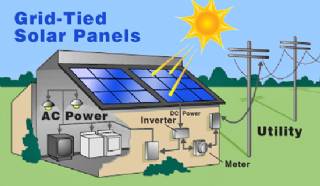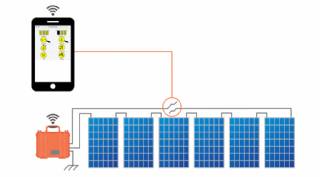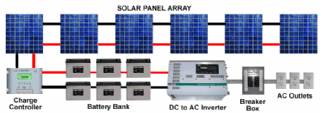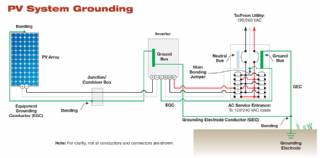How it’s Used Solar Energy System

Solar energy systems use the sun’s light to produce electricity by means of any combination of collecting, transferring, or converting solar generated energy. Two main technologies are currently in use which do this: Photovoltaic (PV devices) or “solar cells” change sunlight directly into electricity through cells that are grouped into panels.
Concentrated Solar Power (CSP) systems use mirrors or lenses to concentrate a large area of sunlight onto a small area to create heat that powers a stream turbine. Large surfaces are required for utility scale systems producing electricity using either technology.
One of the limitations for solar energy is that it depends on the amount of sunlight that reaches the earth. Weather conditions and time of year are two factors that will affect this. In Minnesota, for example, we receive much more solar radiation during the summer months, but limited solar exposure in the winter months when days are shorter. Electricity from solar energy is more heavily concentrated in the lower portion of the state, where there is a slightly smaller effect of diminished daylight hours during the winter months (EIA, 2014).
Current taxation process
Based on the information we were able to gather, the recently-enacted solar energy production tax is the best option for taxation of solar energy producing facilities.
The 2014 changes included:
- Clarifying that solar energy generating systems are exempt
- Creating a solar energy production tax
- Clarifying the classification of property primarily used for solar energy production
There is no process of valuation, allocation, or apportionment as with other energy producing facilities.
The solar energy production tax is $1.20 per megawatt-hour produced on solar energy producing systems with an alternating current (AC) capacity over 1 megawatt. Systems with AC capacities of 1 megawatt or less are exempt from the solar energy production tax.
Revenue annually calculates the amount of solar energy production tax due and notifies the system owners and County Auditors. The tax is paid to the County Treasurer and then distributed – 80 percent to counties and 20 percent to cities and townships. When enacted, the solar energy production tax was based largely on the wind energy production tax.
Variation in taxes
Because solar energy facilities pay a production tax instead of ad valorem taxes, the tax per kWh generated is more uniform among facilities that meet the 1 MW (1,000 kW) capacity threshold. As the solar energy production tax will begin in 2015, no tax amounts were calculated in 2014.
Costs and Benefits
One of the potential concerns with a production tax for solar energy producing systems is that it may impact property owner behavior, as we have seen with the wind energy production tax. Exempting facilities from the tax if they are below a specific generation capacity, or having graduated tax rates based on capacity, creates an incentive for owners to build capacity below the thresholds established in law.
In general, renewable energy sources have very small external costs in comparison to fossil fuels. Solar panels produce no emissions during operation (National Research Council, 2009). Costs to the community may include impacts on wildlife and the area’s landscape.
Benefits to communities for hosting a solar energy facility are similar to other traditional and renewable energy sources. These benefits include a stronger tax base, lower tax rates, and other economic benefits.
Benefits of a production tax are that it is transparent and understandable, simple and efficient to administer, equitable between the solar facilities, and responsive to changes in energy produced. A solar energy production tax is appropriate in that it mirrors taxation of another renewable energy source – wind energy.
For property owners, because the production tax is simpler to calculate, it is easier for companies to understand and comply with.
Since the costs of the impact on wildlife and landscape cannot be quantified, it is inconclusive whether the property tax system adequately accounts for potential costs of hosting solar energy producing facilities.
Labels
solar energy systemhow it is used solarhow used solar energysolar systems usedsolaire energy systemshouse solar energysolar system at homesolar system househome solar power system costthe solar panelsolar energy homesolar installation costsolar panelssolar energyalternative energysolar water heaterhow is it used solar energysolar energy how is it usedFarming Principle: Deep Soil Preparation
Looking at GB as a three-legged stool, deep soil preparation is one of the legs. Deep soil preparation builds soil and soil structure by loosening the soil to a depth of 24 inches (60 cm). Ideal soil structure has both pore space for air and water to move freely and soil particles that hold together nicely.

Smart Home Ecosystem - Smart Home Automation - Smart Home Security - Smart Home Technology
The outer-most level corresponds to the individual devices and sensors that consumers interact with. Several candidates are vying for the role of a leader introducing smart home services to the mass market.

Solar Energy Systems - Solar Modules - Solar Electric System Design - Solar Power
The heart of a photovoltaic system is the solar module. Many photovoltaic cells are wired together by the manufacturer to produce a solar module. When installed at a site, solar modules are wired together in series to form strings. Strings of modules are connected in parallel to form an array.
Solar Energy Systems - Array Mounting Racks - Solar Ray - Solar Panel - PV Racks and Mounts
Arrays are most commonly mounted on roofs or on steel poles set in concrete. In certain applications, they may be mounted at ground level or on building walls. Solar modules can also be mounted to serve as part or all of a shade structure such as a patio cover. On roof-mounted systems, the PV array is typically mounted on fixed racks, parallel to t

Solar Energy Systems - Grounding Equipment
Grounding equipment provides a well-defined, low-resistance path from your system to the ground to protect your system from current surges from lightning strikes or equipment malfunctions. Grounding also stabilizes voltages and provides a common reference point. The grounding harness is usually located on the roof.

Solar Energy Systems - Solar Inverter - Solar Panel Inverter
Most grid-connected inverters can be installed outdoors, while most off-grid inverters are not weatherproof. There are essentially two types of grid-interactive inverters: those designed for use with batteries and those designed for a system without batteries.

Solar Energy Systems - Solar Disconnects
Automatic and manual safety disconnects protect the wiring and components from power surges and other equipment malfunctions. They also ensure the system can be safely shut down and system components can be removed for maintenance and repair.

Solar Energy Systems - Solar Battery Bank
Batteries store direct current electrical energy for later use. This energy storage comes at a cost, however, since batteries reduce the efficiency and output of the PV system, typically by about 10 percent for lead-acid batteries. Batteries also increase the complexity and cost of the system.

Solar Energy Systems - Solar Charge Controller
A charge controller, sometimes referred to as a photovoltaic controller or battery charger, is only necessary in systems with battery back-up. The primary function of a charge controller is to prevent overcharging of the batteries. Most also include a lowvoltage disconnect that prevents over-discharging batteries. In addition, charge controllers pr

Solar Energy Systems - The NEC and PV Systems
Solar PV systems must be installed in accordance with Article 690 of the National Electric Code, which specifically deals with PV systems, as well as several other articles of the NEC that pertain to electrical systems in general. When there is a conflict between NEC 690 and any other article, NEC 690 takes precedence due to the unique nature of PV